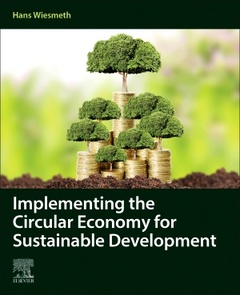Implementing the Circular Economy for Sustainable Development

Implementing the Circular Economy for Sustainable Development presents the concept of the circular economy with the goal of understanding its present status and how to better implement it, particularly through environmental policies. It first tackles the definition of a circular economy in the context of sustainability and the differences in defining the concept across disciplines, including its fallibilities and practical examples. It then goes on to discuss the implementation of a circular economy, including the increasing variety of technological, mechanical, and chemical procedures to contend with and the need for stakeholder support in addition to improved business models.
The second half of the book, therefore, presents tools, approaches, and practical examples of how to shape environmental policy to successfully implement a circular economy. It analyzes deficiencies of current regulations and lays the groundwork for the design of integrated environmental policies for a circular economy.
Authored by an expert in environmental economics with decades of experience, Implementing the Circular Economy for Sustainable Development is a timely, practical guide for sustainability researchers and policymakers alike to move more efficiently toward a circular economy and sustainable development.
1. Introduction
Part I: The Circular Economy – Concept and Facts2. The Circular Economy – Understanding the Concept3. The Circular Economy in Literature and Practice4. Circular Economy – A Hierarchy of Leaders and Followers5. Environmental Regulations with a View on the Circular EconomyPart II: Integrating the Economy and the Environment6. Economic Foundation of a Circular Economy7. Allocating Environmental Commodities8. Behavioural Environmental Economics9. The Economics of Implementing a Circular EconomyPart III: The Circular Economy in a Technological Context10. The Technological Environment of a Circular Economy11. Technology and Information12. The Rebound Effect and Path Dependencies13. The Digital Transformation – An Ongoing Process
Part IV: Features of Environmental Policies14. Environmental Policies for Implementing a Circular Economy15. Environmental Standards16. Market-Oriented Policy Tools17. Holistic Policy Approaches18. The Economics of the Waste HierarchyPart V: Implementing a Circular Economy19. Where are We on the Road to a Circular Economy?20. Packaging Waste in a Circular Economy21. WEEE and ELV in a Circular Economy22. Climate Change Mitigation in a Circular Economy23. Plastics in a Circular Economy24. Textiles in a Circular Economy
Part VI: Concluding Remarks25. Circular Economy - A Summary in Times of Corona
- Presents a clear view of the critical components, features, and issues of a circular economy
- Discusses a variety of practical examples from current policies in the context of a circular economy to better understand the challenges associated with its implementation
- Analyzes strengths and weaknesses of current environmental policies and their interactions with innovations in engineering and science
Date de parution : 11-2020
Ouvrage de 326 p.
19x23.3 cm



